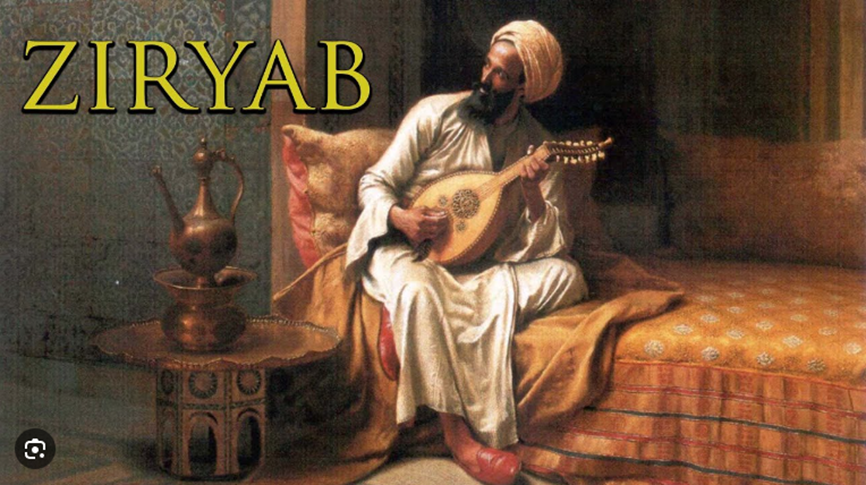 By Neenah Payne
By Neenah Payne
Abu I-Hasan Alí Ibn Nafí (c. 789–c. 857) was a former slave, singer, composer, oud and lute player, poet, teacher, fashion designer, gastronome, and astronomer. He was popularly known as Ziryab (“Black Bird”) because of his dark skin and sweet voice. Ziryab introduced the oud to Spain which evolved into the lute and the guitar. Ziryab introduced chess and polo, changed how people wore their hair and dressed, taught men to shave, introduced toothpaste, soaps, and perfumes, and popularized the three-course meal with refined table settings.
Wikipedia says about Ziryab:
He created a new type of deodorant…and also promoted morning and evening baths and emphasized the maintenance of personal hygiene. Ziryab is thought to have invented an early toothpaste, which he popularized throughout Islamic Iberia….it was reported to have been both “functional and pleasant to taste”….
He popularized shaving among men and set new haircut trends. Royalty used to wash their hair with rose water, but Ziryab introduced the use of salt and fragrant oils to improve the hair’s condition. Ziryab was a “major trendsetter of his time” creating trends in fashion, hairstyles, and hygiene.
He was an arbiter of culinary fashion and taste, who also “revolutionized the local cuisine” by introducing new fruits and vegetables such as asparagus, and by introducing the three-course meal served on leather tablecloths, insisting that meals should be served in three separate courses consisting of soup, the main course, and dessert. He also introduced the use of crystal as a container for drinks, which was more effective than metal. Prior to his time, food was served plainly on platters on bare tables, as with Romans. He is also said to have popularized wine.
Ziryab revolutionized the court at Córdoba and made it the style capital of its time. Whether introducing new clothes, styles, foods, hygiene products, or music, Ziryab changed Andalusian culture forever. Ziryab’s musical contributions laid the early groundwork for classic Spanish music. Thanks to his broad contributions, Ziryab became a revolutionary cultural figure in 8th and 9th century Iberia. Ziryab’s students took the trends and inventions he started to North Africa and Europe.
Ziryab: Father of Andalusian Music?
The Arabs called Spain “Al Andalus” (Land of the Vandals) because Vandals ruled Spain before the Arabs ruled it from 711-1492. The video below says Ziryab is one of the world’s most famous musicians. Yet, most Americans have never heard of him. In Cordoba in southern Spain, Ziryab founded the first European school of music which made Cordoba a center of music on a par with and Medina and Baghdad where Ziryab had grown up. Cordoba became the intellectual center of Europe.
The video says,
The influence and stature of Ziryab cannot be overstated. He is often considered the founder of that musical tradition that survives to this day in places like Morocco, Algeria, and Tunisia – and, of course, also later influenced the music of Europe.
Ziryab brought with him other aspects of the culture of Baghdad which revolutionized many aspects of courtly fashion in Cordova. He brought the oud into Europe, composed popular songs, opened a successful school of music, essentially became a fashion designer, and influenced dining etiquette. Bands, hotels, and restaurants are named after him. Ziryab is still a celebrity today – 1,200 years later.
Ziryab – The Father of Andalusian Music?
We talk about the famous 9th century musician Ziryab (“Blackbird”) who changed the music and court culture of Umayyad Spain to a massive degree.
Ziryab’s Impact On Europe
Ziryab, the Musician, Astronomer, Fashion Designer, and Gastronome
Abul-Hasan Alí Ibn Nafí, nicknamed Ziryab, was Chief Entertainer of the Court of Cordoba in 822AD. He revolutionised medieval music, lifestyle, fashion, hairstyles, furniture, and even tableware. He transformed the way people ate, socialised, and relaxed.
Abul-Hasan Alí Ibn Nafí, known as Ziryab, was born in Iraq in 789. He was nicknamed Ziryab because of his melodious voice and his dark complexion, features which people compared with a singing bird of black plumage [hence his nickname Blackbird].
He was a gifted pupil of Ishaq al-Mawsili, a renowned musician in Baghdad and a favourite of the Abbasid Caliph Harun Al-Rashid. Ziryab’s talent and excellence in music slowly overtook the position of his teacher, which brought him close to the Caliph and his court. Al-Hakem, the Umayyad Caliph and father of Abd-Al-Rahman II invited him to Andalusia.
Zaryab settled in Cordoba in 822, at the court of the then Caliph Abd-Al-Rahman II. His arrival coincided with a new impetus given by Abd-Al-Rahman II to cultural life, leading Andalusia to one of its major flowering periods. In Cordoba, Ziryab found prosperity, recognition of his art and unprecedented fame. He became the court entertainer with a monthly salary of 200 golden Dinars in addition to many privileges. This promotion gave him a great opportunity to let his talent and creation break free.
In music, he was the first to introduce the lute (Al-U’d) to Spain and Europe. He is credited, with Al-Kindi, with the addition of the fifth bass string to it and substituted the wooden plectrum for the eagle’s quill. In Spain, as well as North Africa, he substituted the singing system of Medina with that of Iraq (Reference: Plaencia, G. (1928), ‘ History of Literature Arabic-Spanish’, Barcelona, page 41).
He established the first conservatoire in the world, which included the teaching of harmony and composition. Regarding musical theory, he rearranged it completely, setting free the metrical and rhythmical parameters and creating new ways of expression. He knew more than one thousand songs, of which some, according to Al-Maqqari, belong to Ptolemy.
He transformed social customs as seen in dress and hair styling, in the kitchen and the way people eat, socialise and relax, and in the furniture and tools he invented to follow this transformation in living. He replaced the gold glasses by others made of glass and crystal.
He spread the use of the tablecloth and the wearing of white dress in the summer. He also introduced new culinary recipes, new tableware, new sartorial fashions and even the games of chess and polo.
Ziryab’s achievements gained him respect of the following generations, even till the present day. In the Muslim world, there is not a single country that does not have a street, a hotel, a club or a café named after him. In the West, scholars and musicians still pay him tribute today.
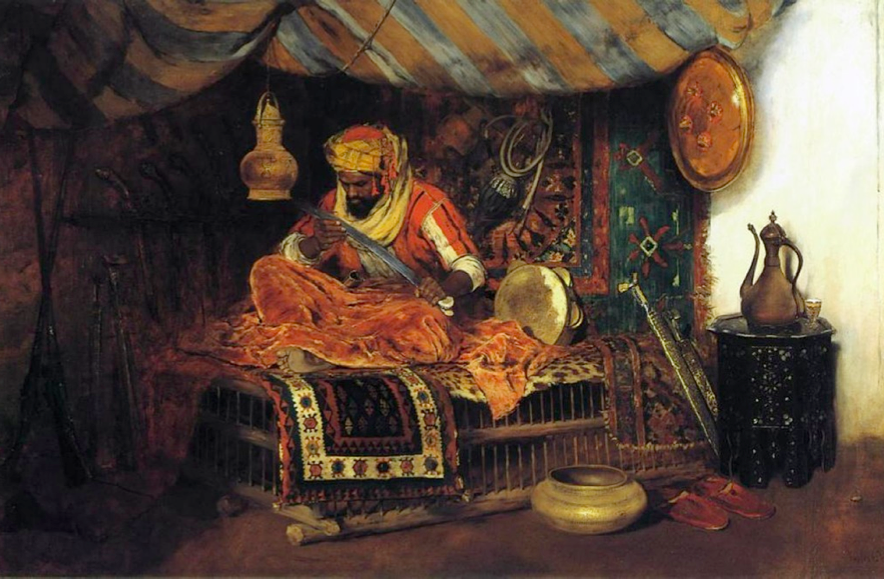 Imaginary Portrait of Ziryab – An Anonymous Personality in European history (Source)
Imaginary Portrait of Ziryab – An Anonymous Personality in European history (Source)
An example is Henry Terrace who wrote the following: “After the arrival of this oriental (Ziryab), a wind of pleasure and luxurious life blew through Cordoba. An atmosphere filled with poetry and exquisite delight surrounded Ziryab. He gave his art an unprecedented value, nearly magic, especially as he explains the symbolic significance of the strings of the lute. He maintained that the first four represented the bile (bitterness of temper), the coolness, blood and the black moods, while the fifth he considered as the soul. He was also a scholar renowned for his knowledge in astronomy and geography
Ziryab became connected to themes of elegance; with his refined and luxurious tastes he defined the court of the Caliphs. He brought from the Orient the toilet accessories (perfumes, cosmetics, toothpaste) and new modes, which left great impact. Most Cordobans imitated his hairstyle. This great artist was also a gastronome introducing a number of exotic unknown recipes.
Ziryab launched a number of modes and fashions, which lasted for centuries. He brought to Spain crystal glasses and leather furniture. He introduced winter and summer dresses, setting exactly the dates when each fashion is worn. He also added dresses of half season for between seasons. Through him, the luxurious dress of the Orient was introduced in Spain. Under his influence, a fashion manufacturing was set up producing coloured striped fabric and coats of transparent fabric, which is still found in Morocco today.
Ziryab: The Greatest Cultural Icon You Never Heard Of
Ziryab – The slave who changed society but still remains anonymous in European History
Ziryab — the greatest cultural icon you never heard of
How did a medieval Muslim become a fashion icon? This is the story of Ziryab, a massive cultural pioneer you need to know.
How Ziryab Revolutionized Western Culture
If you eat asparagus, or if you start your meal with soup and end with dessert, or if you use toothpaste, or if you wear your hair in bangs, you owe a lot to one of the greatest musicians in history. He was known as Ziryab, a colloquial Arabic term that translates as “blackbird.” He lived in Medieval Spain more than a thousand years ago. He was a freed slave who made good, charming the royal court at Córdoba with his songs. He founded a music school whose fame survived more than 500 years after his death.
Ibn Hayyan of Córdoba, one of Arab Spain’s greatest historians, says in his monumental Al-Muqtabas or The Citation that Ziryab knew thousands of songs by heart and revolutionized the design of the musical instrument that became the lute. He spread a new musical style around the Mediterranean, influencing troubadours and minstrels and affecting the course of European music.
He was also his generation’s arbiter of taste, style, and manners, and he exerted enormous influence on Medieval European society. How people dressed, what and how they ate, how they groomed themselves, what music they enjoyed all were influenced by Ziryab.
If you’ve never heard of this remarkable artist, it’s not surprising. With the twists and turns of history, his name has dropped from public memory in the Western world. But the changes he brought to Europe are very much a part of the reality we know today.
One reason Ziryab is unknown to us is that he spoke Arabic, and was part of the royal court of the Arab empire in Spain. Muslims from Arabia and North Africa ruled part of Spain from 711 until 1492. The last remnant of Arab rule in the Iberian Peninsula, the Kingdom of Granada, was conquered by the armies of King Ferdinand and Queen Isabella in the same year that Columbus sailed for the New World.
The Arabs called their Iberian domain Al-Andalus a direct reference to the Vandals, who occupied the peninsula in the fifth century and whose legacy was still pervasive when Muslim forces arrived in the eighth. That name survives today in the name of Spain’s southern province, Andalusia.
At its peak, Al-Andalus experienced a golden age of civilization that was the envy of all Europe, and which set the stage for the European Renaissance that followed. Muslims, Christians, and Jews interacted in a convivencia a “living-together” of tolerance and cooperation unparalleled in its time. Influences from Arab Spain spread to France and throughout Europe, and from there to the Americas. It was in this context that the achievements of Ziryab became part of western culture.
Ziryab’s achievements were not forgotten in the Arab world, and it is from historians there that we know of his life and accomplishments. As the 17th-century Arab historian al-Maqqari says in his Nafb al-Tib or Fragrant Breeze, “There never was, either before or after him, a man of his profession who was more generally beloved and admired.”…
According to Ibn Hayyan, ‘Ali Ibn Nafi’ was called Blackbird because of his extremely dark complexion, the clarity of his voice and “the sweetness of his character.” Blackbird studied music under the famous singer and royal court musician Ishaq al-Mawsili or Isaac of Mosul. Ishaq, his even more celebrated father, Ibrahim, and Ziryab are the three artists known as the fathers of Arabic music.
Baghdad was then a world center for culture, art, and science. Its most famous ruler was Harun al-Rashid, who succeeded al-Mahdi. Harun was a lover of music, and brought many singers and musicians to the palace for the entertainment of his guests. Ishaq, as Harun’s chief musician, trained a number of students in the musical arts, among them Blackbird. Ziryab was intelligent and had a good ear; outside his lessons, he surreptitiously learned the songs of his master, which were said to have been complex and difficult even for an expert. Ishaq did not realize how much Ziryab had learned until Harun himself asked to hear the young musician.
In Ibn Hayyan’s account, Ishaq told the caliph, “Yes, I’ve heard some nice things from Ziryab, some clear and emotional melodies particularly some of my own rather unusual renditions. I taught him those songs because I considered them especially suited to his skill.” Ziryab was summoned, and he sang for Harun al-Rashid. Afterward, when the caliph spoke to him, Ziryab answered “gracefully, with real charm of manner.”
Harun asked him about his skill, and Blackbird replied, “I can sing what the other singers know, but most of my repertory is made up of songs suitable only to be performed before a caliph like Your Majesty. The other singers don’t know those numbers. If Your Majesty permits, I’ll sing for you what human ears have never heard before.”
Harun raised his eyebrows, and ordered that master Ishaq’s lute be handed to Ziryab.…. Ziryab respectfully declined the instrument. “I’ve brought my own lute,” he said, “Which I made myself, stripping the wood and working it, and no other instrument satisfies me. I left it at the palace gate and, with your permission, I’ll send for it.” Harun sent for the lute and he examined it. It looked like Ishaq al-Mawsuli’s instrument “Why won’t you play your master’s lute?” the caliph asked.
“If the caliph wants me to sing in my master’s style, I’ll use his lute. But to sing in my own style, I need this instrument.” “They look alike to me,” Harun said. “At first glance, yes,” said Ziryab, “But even though the wood and the size are the same, the weight is not. My lute weighs about a third less than Ishaq’s, and my strings are made of silk that has not been spun with hot water which weakens them. The bass and third strings are made of lion gut, which is softer and more sonorous than that of any other animal. These strings are stronger than any others, and they can better withstand the striking of the pick.” Ziryab’s pick was a sharpened eagle’s claw, rather than the usual piece of carved wood. He had also, added a fifth course of strings to the instrument.
Harun was satisfied. He ordered Ziryab to perform, and the young man began a song he had composed himself. The caliph was quite impressed. He turned to al-Mawsuli and said, “If I thought you had been hiding this man’s extraordinary ability, I’d punish you for not telling me about him. Continue his instruction until it’s completed. For my part, I want to contribute to his development.”
Ziryab had apparently concealed his finest talents from his own teacher. When Ishaq was finally alone with his pupil, he raged about being deceived. He said frankly that he was jealous of Ziryab’s skill, and feared the pupil would soon replace the master in the caliph’s favor. “I could pardon this in no man, not even my own son,” Ishaq said. “If I weren’t still somewhat fond of you, I wouldn’t hesitate to kill you, regardless of the consequences. Here is your choice: Leave Baghdad, take up residence far from here, and swear that I’ll never hear from you again. If you do this, I’ll give you enough money to meet your needs. But if you choose to stay and spite me I warn you, I’ll risk my life and all I possess to crush you. Make your choice!”…
Ziryab and his family fled from Baghdad to Egypt and crossed North Africa to Kairouan in present-day Tunisia, seat of the Aghlabid dynasty of Ziyadat Allah I. There he was welcomed by the royal court. But he had no intention of staying in Kairouan; his eyes were on Spain.
Under the Umayyads, Córdoba was fast becoming a cultural jewel to rival Baghdad, and Blackbird thought Córdoba might be a fit setting for his talents. Ziryab wrote to al-Hakam, ruler of the emirate of Al-Andalus, and offered his musical skills. Al-Hakam, delighted with the prospect of adding a Baghdad musician to his court, wrote back inviting Ziryab to proceed to Córdoba. He offered the musician a handsome salary….When Ziryab arrived in Spain in the year 822, he was shocked to learn that al-Hakam was dead…. But thanks to the glowing recommendation of Abu al-Nasr Mansur, a Jewish musician of the Córdoban royal court, al-Hakam’s son and successor ‘Abd al-Rahman II renewed the invitation to Ziryab.
After meeting with the 33-year-old wonder from Baghdad, ‘Abd al-Rahman who was about the same age made him an attractive offer. Ziryab would receive a handsome salary of 200 gold pieces per month, with bonuses of 500 gold pieces at midsummer and the new year and 1,000 on each of the two major Islamic holidays. He would be given 200 bushels of barley and 100 bushels of wheat each year. He would receive a modest palace in Córdoba and several villas with productive farmland in the countryside. Naturally, Ziryab accepted the offer; overnight he became a prosperous member of the landed upper class in Islamic Spain.
Abd al-Rahman’s objective in hiring the young musician was to bring culture and refinement to the rough-and-ready country of Al-Andalus, the wild west of the Arab world and not too long ago a “barbarian” Gothic land far from the civilized centers of Damascus and Baghdad. The ruler’s own Umayyad family had come as exiles from Damascus, where they had ruled an Islamic empire for several hundred years. Now the power rested with the Abbasids in Baghdad, and that city had become a magnet for scientists, artists, and scholars of all descriptions.
In fact, ‘Abd al-Rahman offered Ziryab employment before even asking him to perform. And when he eventually did hear Ziryab’s songs, contemporaries say the ruler was so captivated that he would never again listen to another singer. From that day forward, ‘Abd al-Rahman and Ziryab were close confidants, and would often meet to discuss poetry, history, and all the arts and sciences.
Ziryab served as a kind of minister of culture for the Andalusi realm. One of his first projects was to found a school of music, which opened its doors not only to the talented sons and daughters of the higher classes but also to lower-class court entertainers. Unlike the more rigid conservatories of Baghdad, Ziryab’s school encouraged experimentation in musical styles and instruments. While the academy taught the world-famous styles and songs of the Baghdad court, Ziryab quickly began introducing his innovations and established his reputation as, in the words of the Encyclopaedia of Islam, “the founder of the musical traditions of Islamic Spain.”
Ziryab loved well-prepared food almost as much as he did music. He revolutionized the arts of the table in Spain, in ways that survive to this day. Before Ziryab, Spanish dining was a simple, even crude, affair, inherited from the Visigoths, the successors of the Vandals, and from local custom. Platters of different foods were piled together, all at the same time, on bare wooden tables. Table manners were nonexistent.
A wide array of foods was available in Al-Andalus meats, fish and fowl, vegetables, cheeses, soups and sweets. Ziryab combined them in imaginative recipes, many originating in Baghdad. One of these dishes, consisting of meatballs and small triangular pieces of dough fried in coriander oil, came to be known as taqliyat Ziryab, or Ziryab’s fried dish; many others bore his name as well.
He delighted court diners by elevating a humble spring weed called asparagus to the status of a dinner vegetable. Ziryab developed a number of delectable desserts, including an unforgettable treat of walnuts and honey that is served to this day in the city of Zaragoza…..
With the emir’s blessing, Ziryab decreed that palace dinners would be served in courses according to a fixed sequence, starting with soups or broths, continuing with fish, fowl or meats, and concluding with fruits, sweet desserts and bowls of pistachios and other nuts. This presentation style, unheard of even in Baghdad or Damascus, steadily gained in popularity, spreading through the upper and merchant classes, then among Christians and Jews, and even to the peasantry. Eventually the custom became the rule throughout Europe. The English expression “from soup to nuts,” indicating a lavish, multi-course meal, can be traced back to Ziryab’s innovations at the Andalusi table.
Dressing up the plain wooden dinner table, Ziryab taught local craftsmen how to produce tooled and fitted leather table coverings. He replaced the heavy gold and silver drinking goblets of the upper classes a holdover from the Goths and Romans with delicate, finely crafted crystal. He redesigned the bulky wooden soup spoon, substituting a trimmer, lighter model.
For women, Blackbird opened a beauty parlor/cosmetology school not far from the Alcazar, the emir’s palace. He created hairstyles that were daring for the time. The women of Spain traditionally wore their hair parted in the middle and covering their ears, with a long braid down the back. Ziryab introduced a shorter, shaped cut, with bangs on the forehead and the ears uncovered. He taught the shaping of eyebrows and the use of depilatories for removing body hair. He introduced new perfumes and cosmetics.
Some of Ziryab’s fashion tips were borrowed from the elite social circles of Baghdad, then the world’s most cosmopolitan city. Others were twists on local Andalusi custom. Most became widespread simply because Ziryab advocated them; he was a celebrity, and people gained status simply by emulating him.
As an arbiter of courtly dress, he decreed Spain’s first seasonal fashion calendar. In springtime, men and women were to wear bright colors in their cotton and linen tunics, shirts, blouses and gowns. Ziryab introduced colorful silk clothing to supplement traditional fabrics. In summer, white clothing was the rule. When the weather turned cold, Ziryab recommended long cloaks trimmed with fur, which became all the rage in Al-Andalus.
Ziryab exercised great clout at the emir’s court, even in political and administrative decision-making. ‘Abd al-Rahman II has been credited with organizing the “norms of the state” in Al-Andalus, transforming it from a Roman-Visigothic model to one set up along Abbasid lines. Ziryab is said to have played a significant role in this process. Ziryab brought in astrologers from India…. The astrologers were grounded in astronomy, and Ziryab encouraged the spread of this knowledge. The Indians also knew how to play chess, and Ziryab had them teach the game to members of the royal court, and from there it spread throughout the peninsula.
Abd al-Rahman II died in about 852, and his remarkable innovator Ziryab is believed to have followed about five years later.…As ‘Abd al-Rahman II and Ziryab departed the stage, Córdoba was coming into its own as a cultural capital and seat of learning. By the time another ‘Abd al-Rahman, the third, took power in 912, the city had become the intellectual center of Europe. As historian James Cleugh said of Córdoba in Spain in the Modern World, “there was nothing like it, at that epoch, in the rest of Europe. The best minds in that continent looked to Spain for everything which most clearly differentiates a human being from a tiger.”
As the first millennium drew to a close, students from France, England, and the rest of Europe flocked to Córdoba to study science, medicine, and philosophy and to take advantage of the great municipal library, with its 600,000 volumes. When they returned to their home countries, they took with them not only knowledge, but also art, music, cuisine, fashion, and manners.
Europe found itself awash with new ideas and new customs, and among the many streams that flowed northward from the Iberian Peninsula, more than one had been channeled by Ziryab.
Ziryab revolutionized the court at Córdoba and made it the style capital of its time. Whether introducing new clothes, styles, foods, hygiene products, or music, Ziryab changed Andalusian culture forever. Ziryab’s musical contributions laid the early groundwork for classic Spanish music. Thanks to his broad contributions, Ziryab became a revolutionary cultural figure in 8th and 9th century Iberia.
Ziryab’s students took the trends and inventions he started to North Africa and Europe.
Monument of Ziryab represented as a blackbird in Córdoba, Spain
Muslim Impact on Spanish and European Culture
ABBAS IBN FIRNAS OF CORDOBA The World’s First Pilot, First Aviator
A period stretching over 700 years witnessed the Islamic world making scientific progress; a period unprecedented in the last three millennium. At the beginning of that era, Baghdad was the centre of Scientific World, Qutuba Al-Andalus (Cordoba, Spain) became one of the learning centres of the Muslim world, and Europe was languishing in its dark ages. During the European dark ages, the international language of science was Arabic.
Many rulers and caliphs who supported scholarship and science were also the most cultured, passionate, and enthusiastic human beings. They not only advanced the openness towards other religions and cultures, but provided a vibrant sense of optimism and freedom of expression.
Cordoba’s greatest years of glory were from 756 to 1031 when it was the capital of al-Andalus. The progressive growth provided increasing importance for Cordoba and made it the largest and greatest city in Europe by the 10th century, dazzling with its social and multicultural activities, with Muslims, Jews, and Christians mingling at all levels.
The people were awed by the splendour and magnificence of the caliph’s court and the city of Cordoba, a city that had narrow, cool, and paved streets, known for their cleanliness; public lighting; luxurious villas; indoor plumbing for real water closets along the banks of the Guadalquivir river; patios, gardens, fountains and public baths.
The activity of buying and selling was organised, like the market places in Moroccan towns, by areas or streets. Those selling perfumes and spices were allowed to trade outside the mosques, but sellers of aromatic goods were moved off to outer areas. The skilled artisans and agricultural infrastructure converted Cordoba into a booming economy. It became famous for its leather and metal work, glazed tiles and textiles.
A variety of agricultural goods introduced by Muslims to Europe were astonishingly delicious. They were oranges, lemons, limes, watermelons, figs, pomegranates, almonds, bananas, artichokes, eggplants, spinach, sugar-cane on the side of herbs and spices such as cumin, caraway, coriander, fennel, mint, parsley, cloves, and nutmeg. In addition to this, there were cash crops such as cotton, flax, and silk.
The video below explains that Muslims ruled Spain from 711-1492 – for about 800 years. It shows the enormous impact of Arabs on the Spanish language, foods, and culture. It says 8% of Spanish is derived from Arabic — one out of every 12 words. Almost any Spanish word that begins with “Al” is derived from Arabic.
The secret Muslim history of Spanish Culture 9/1/22
Islam was a social and political force in Spain for over 800 years; 3 times the entire history of the United States. And yet, the impact the Muslims had on Spain and modern Spanish culture is rarely ever acknowledged. In this episode, I tell you the story of how Islam entered Spain, how the Muslims of that time still have influence on modern Spanish Culture and some possible reasons why Spain’s Muslim past is rarely discussed today.
Neenah Payne writes for Activist Post
Become a Patron!
Or support us at SubscribeStar
Donate cryptocurrency HERE
Subscribe to Activist Post for truth, peace, and freedom news. Follow us on SoMee, Telegram, HIVE, Minds, MeWe, Twitter – X, Gab, and What Really Happened.
Provide, Protect and Profit from what’s coming! Get a free issue of Counter Markets today.

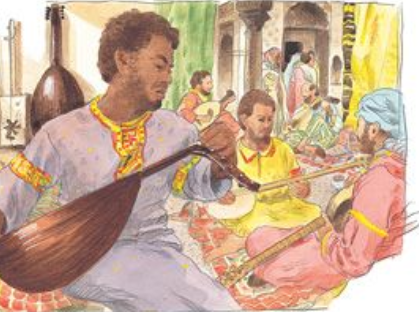

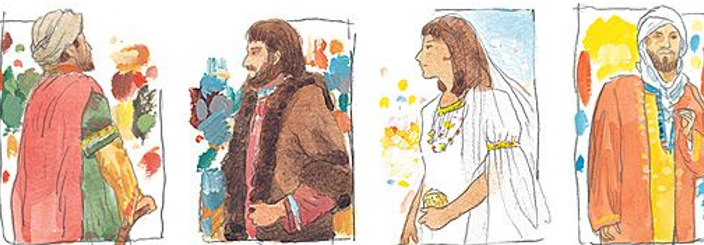
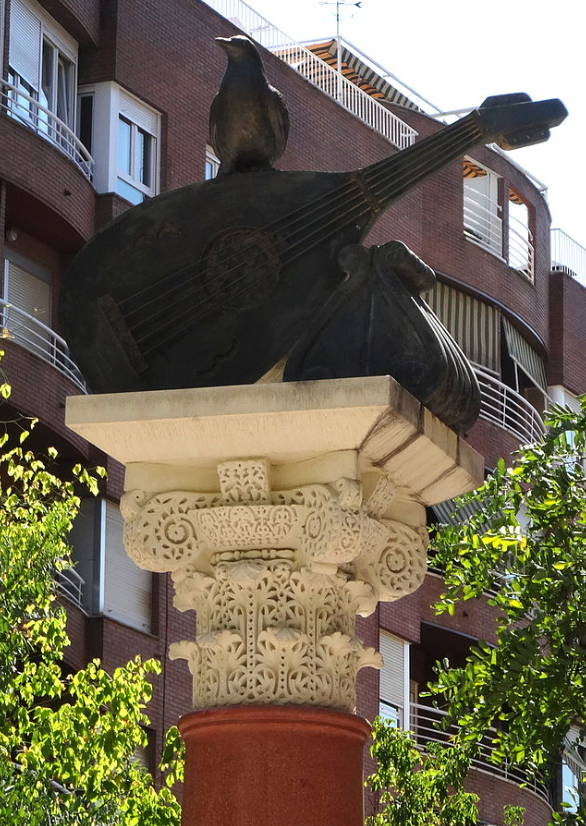
Be the first to comment on "The Muslim Who Taught Europe How To Live!"